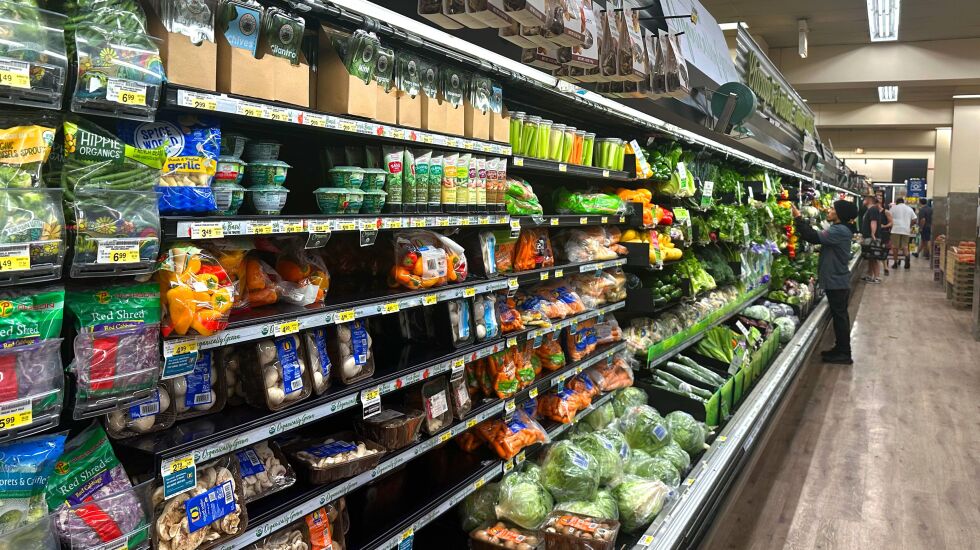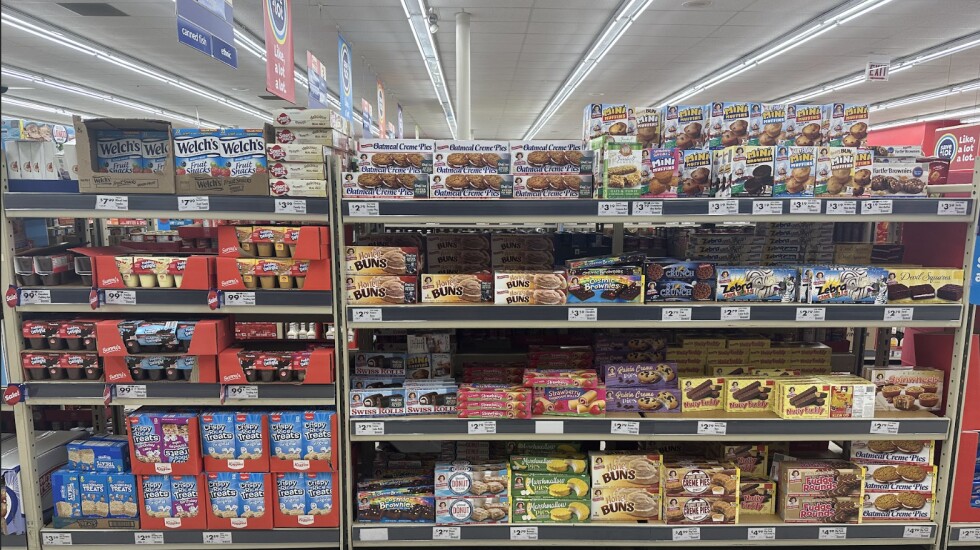
Scanning the aisles of the Englewood Save A Lot, Martisha Mack is on a mission. She’s looking for canned chili but typically wouldn’t head to the former Whole Foods location because she looks for “healthier options.”
She steers clear of perishables — about a dozen milks sit expired nearby in the dairy fridge.
Nine months ago, the store at 832 W. 63rd St. was a Whole Foods. Mack, 29, a Bronzeville resident, would stop by each week to grab produce, nondairy milk and seasonings.
Now, she won’t rely on the Save A Lot — meant to fill a void of low-food access on the South Side — for her groceries since it opened in May.
“I hate to say that I’m not surprised, but I just don’t think stores [on the South Side] are prioritized, and sometimes I think the overlooking is intentional,” Mack said.
Low-food access in Chicago has jumped by 63% in the past decade, a WBEZ-Chicago Sun-Times analysis found, painting a bleak picture for people on the South Side and the West Side who might not have access to thriving supermarkets.

Several major stores closings in recent months — including those of a Walmart Supercenter in Chatham, a Whole Foods in Englewood and an Aldi in Gresham — have left people living in these neighborhoods upset and scrambling to find full-service stores where they can buy fresh healthy foods at low cost.
Some have blasted the presence of discount grocers, such as Save A Lot and Food 4 Less, and an increasing number of dollar stores, as unsuitable substitutes for the major grocers that have moved out, questioning whether these stores offer high-quality, healthy or diverse options. Food access and industry experts agree.
Emanuel’s push for grocers
Former Mayor Rahm Emanuel began his first term in 2011 by making food access a priority, with an initiative to bring grocers to areas still largely segregated by race.
His time in office saw the Walmart Supercenter open in Chatham in 2012 and a Whole Foods in Englewood in 2016. Two years into the initiative, the mayor’s office produced numbers to show food access had improved.
In the last year, though, the supercenter and Whole Foods closed, prompting an uproar from shoppers.
Also during Emanuel’s term, Target closed two locations on the South Side, and Dominick’s went out of business, closing 15 Chicago locations. Kmart closed its final store in Chicago in 2018.
Most of the major grocers that have opened have notably been on the North Side.
Tax breaks including city tax-increment financing had been used to lure stores like Whole Foods, Save A Lot and Walmart.
“Ten years ago, there was real intention to grow these neighborhoods, which is why you’re now seeing some of them pulling out,” said Steve Caine, a Chicago senior partner with consulting firm Bain & Company’s retail division.
After announcing the closings of half of their Chicago locations in April, Walmart said all of its stores in the city remained unprofitable even after trying “different strategies.”
Grocery operators have pointed to crime and homelessness as reasons they’ve needed to invest more in security, driving up costs, according to Amanda Lai, a Chicago director of food industry practice for the consulting firm McMillanDoolittle. These grocers also deal with hefty overhead costs in cities.
Ruby Ferguson, who is Mayor Brandon Johnson’s food equity policy lead, said having a variety of options is key for all communities, though she did not say how City Hall would try to lure major grocers.
“It’s a key part of the vision for food equity and justice,” she said. “That choice, that variety... all of these things accessible to every Chicagoan. It goes back to leaning on traditional solutions, while also innovating and exploring new ways.”
Emanuel’s 2013 goal to eradicate “food deserts” by 2020 was “laudable,” but those efforts weren’t sustained, according to Elaine Waxman, a food access expert.

Discount grocers remain
What remains to fill the void of supermarkets and superstores in many of these areas are discount grocers.
Not all discount grocers are created equal, experts say.
Lai and Phil Lempert, a food trend expert known as the “Supermarket Guru,” deem Aldi — a chain that has stayed in the city but still closed stores — as a better, on-trend, cost-efficient alternative to Save A Lot.
Save A Lot, whose Englewood location replaced the shuttered Whole Foods, prompted protests regarding expired food, unhealthy options and unclean stores.
“It is known as one of the worst grocery operators, poor quality products, less-than-fresh produce, off-brand products,” Ald. Stephanie Coleman (16th) said in April. “If you visit any of their stores, you’ll see that we just deserve better.”
Save A Lot locations under the ownership of a company called Yellow Banana have opened on the South Side and the West Side. Save A Lot locations have closed unexpectedly, and Yellow Banana owners have acknowledged poor store conditions and expired foods. A location closed briefly in 2022 due to a rat infestation.
A parent stopping for baby food at Save A Lot will pay 70 cents more for the same product than at Jewel, whose deals for staple items, such as bread and milk, will save shoppers.

When a reporter tried to buy a gallon of expired fat-free skim milk at the Englewood Save A Lot, a cashier searched for a non-expired gallon of the same kind but came up empty.
“Would I take it home and put it in the fridge? I wouldn’t want my kids to drink it, for sure,” Yellow Banana CEO Joe Canfield said in April about another expired milk that was found on store shelves in a West Garfield Park location.
“We have to do a better job of trying to stay on top of that,” he told residents in a May meeting. “We have category rotation schedules, we rotate dairy every day… but sometimes we make mistakes.”
A Mariano’s — also in Lakeview — included similar prices to Save A Lot, and more competitive sales.
According to experts, providing access to quality groceries hits a roadblock when supermarkets pull up stakes in Black and Brown neighborhoods, leaving them with smaller grocery stores that offer fewer options — often not at competitive prices — for fresh foods.
“On the North Side, do we expect our community neighbors to be satisfied with just a Save A Lot?” Waxman said.
Low food access, by the city’s 2013 definition, meant “living in a census block located more than a mile from a large grocery store.”
A commonly used definition of low food access considers how far people are from and supermarkets and supercenters, plus large grocery stores.
Chains like Jewel-Osco, Aldi and Trader Joe’s are categorized as supermarkets. Superstores include Mariano’s, Pete’s Fresh Market and Target.
However, establishments categorized as large grocery stores include corner stores, butcher shops, liquor stores and international food stores.
“Just because the store carries a few of the staple items doesn’t mean that it has affordable food so people can prepare a variety of foods at home,” Waxman said.
In 2013, 38,000 Chicago residents lived more than a mile from a supermarket or superstore. The number rose to 102,000 residents by 2023, a WBEZ and Sun-Times analysis found.
One advantage of supermarkets and superstores, Waxman said, “is the variety of foods that people can get. They tend to have more competitive prices.”

Target, Mariano’s, Pete’s Fresh Market and Trader Joe’s are the supermarkets and superstores in Chicago that have seen consistent growth in the last decade, primarily near the Loop and on the North Side.
Black residents’ food access went drastically down during the past decade, with the number of people experiencing food scarcity going up by 197%, according to the WBEZ and Sun-Times analysis. In 2023, one in every 12 Black residents is experiencing low-food access, compared to one in every 105 white residents, the analysis shows.
Roseland, a South Side neighborhood with over 38,000 residents — 94% Black — has no supermarket or superstores. The Near West Side, with a white plurality, has 11 major grocery stores.
“Some chains saw locations in more prosperous areas as more desirable,” said Tracey Deutsch, a University of Minnesota capitalism and grocers professor. “They were concentrated in areas of higher income, and those were often whiter areas.”
The location of a majority of supermarkets and superstores paints a telling story of where major grocers are willing to venture.
“Whether or not redlining and racism are causes of chains leaving these areas, it reproduces exclusion,” Deutsch said. “It definitely gives poverty a new dimension, and it frankly gives living in a Black neighborhood a new dimension.”
What comes next?
Lempert said he thinks high-quality national grocers can make it in Chicago, with some alterations. He points to Grocery Outlet, a low-cost chain that has stores primarily on the East Coast and the West Coast.
“One of the hidden secrets to Grocery Outlet is they’re individually owned,” Lempert said. “Typically, the people who own them also live in that neighborhood… It’s much more personal than Save A Lot, which I find very impersonal.”
When Save A Lot was named as Whole Foods’ replacement, then-Mayor Lori Lightfoot said, “Despite the fact we talked to all of the grocery chains in the city, we had no takers.”
If city officials can’t find grocers to fill the space, Waxman said, they need to fund a different solution — like community-based grocery stores, instead of forcing stores communities oppose.
“If private-sector chains won’t solve the problem, then [City Hall] has to come up with some other solution,” she said. “We can’t just say, ‘Well, we tried, and they wouldn’t come.’ Well, OK, do better.”







